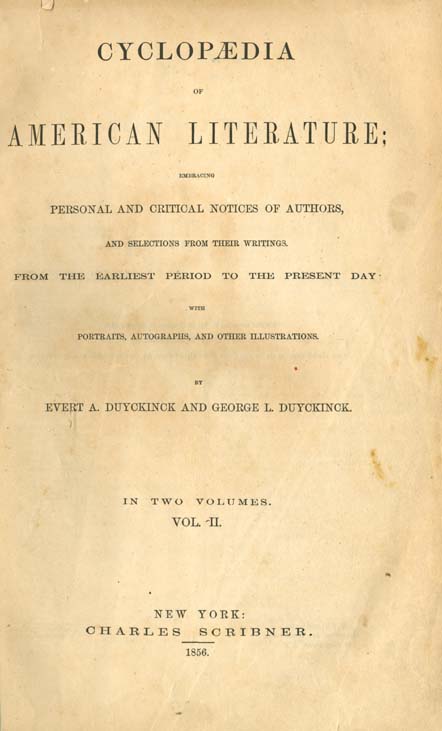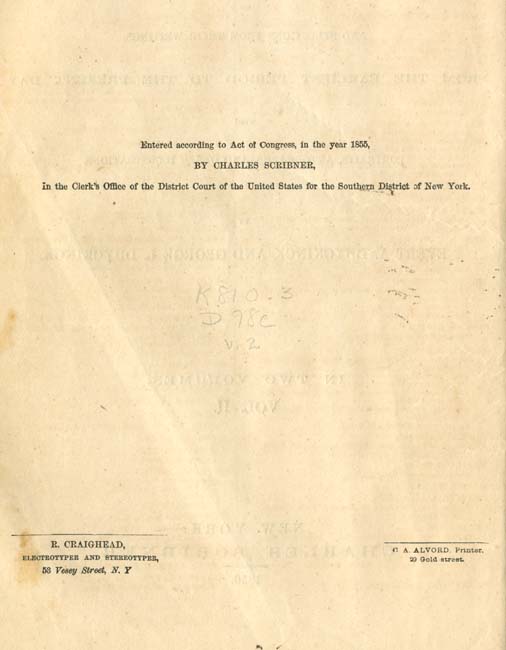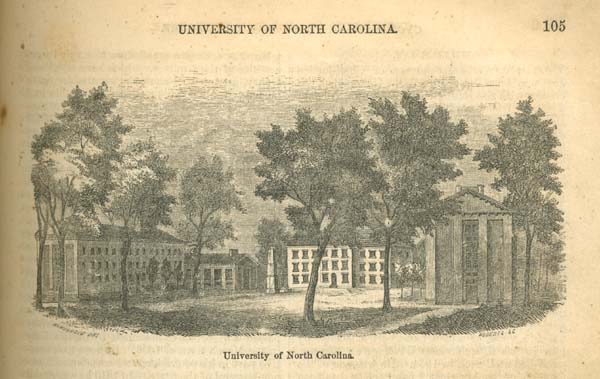University of North Carolina. From Cyclopædia of American Literature; Embracing Personal and Critical Notices of Authors, and Selections from Their Writings. From the Earliest Period to the Present Day with Portraits, Autographs, and Other Illustrations. By Evert A. Duyckinck and George L. Duyckinck. In Two Volumes. Vol. II:
Electronic Edition.
Duyckinck, Evert A. (Evert Augustus), 1816-1878,
Duyckinck, George L. (George Long), 1823-1863
Funding from the State Library of North Carolina supported the electronic publication of this title.
Text scanned (OCR) by
Brian Dietz
Images scanned by
Brian Dietz
Text encoded by
Brian Dietz and Elizabeth S. Wright
First edition, 2005
ca. 22K
University Library, UNC-Chapel Hill
University of North Carolina at Chapel Hill,
2005.
Source Description:
(caption title) University of North Carolina
(title page) From Cyclopædia of American Literature; Embracing Personal and Critical Notices of Authors, and Selections from Their Writings. From the Earliest Period to the Present Day with Portraits, Autographs, and Other Illustrations. By Evert A. Duyckinck and George L. Duyckinck. In Two Volumes. Vol. II
Evert A. Duyckinck and George L. Duyckinck
2 p., ill.
New York
Charles Scribner
1856
From Cyclopædia of American Literature; Embracing Personal and Critical Notices of Authors, and Selections from Their Writings. From the Earliest Period to the Present Day with Portraits, Autographs, and Other Illustrations. By Evert A. Duyckinck and George L. Duyckinck. In Two Volumes. Vol. II.
Call number PS85 .D6 (Davis Library Reference Department, University of North Carolina at Chapel Hill)
The electronic edition is a part of the UNC-Chapel Hill digitization project, Documenting the American South.
This electronic edition has been created by Optical Character Recognition (OCR). OCR-ed text has been compared against the original document and corrected.
The text has been encoded using the recommendations for Level 4 of the TEI in Libraries Guidelines.
Original grammar, punctuation, and spelling have been preserved. Encountered typographical errors have been preserved, and appear in red type.
All footnotes are moved to the end of paragraphs in which the reference occurs.
Any hyphens occurring in line breaks have been removed, and the trailing part of a word has been joined to the preceding line.
All quotation marks, em dashes and ampersand have been transcribed as entity references.
All double right and left quotation marks are encoded as " and " respectively.
All single right and left quotation marks are encoded as ' and ' respectively.
All em dashes are encoded as --
Indentation in lines has not been preserved.
Running titles have not been preserved.
Spell-check and verification made against printed text using Author/Editor (SoftQuad) and Microsoft Word spell check programs.
Library of Congress Subject Headings
Languages Used:
- English
LC Subject Headings:
- University of North Carolina (1793-1962) -- Alumni and alumna.
- University of North Carolina (1793-1962) -- Faculty.
- University of North Carolina (1793-1962) -- History.
Revision History:
- 2005-03-24,
Celine Noel and Wanda Gunther
revised TEIHeader and created catalog record for the electronic edition.
-
2005-01-05,
Elizabeth S. Wright,
finished TEI-conformant encoding and final proofing.
-
2004-12-02,
Brian Dietz
finished TEI/SGML encoding.
- 2004-11-05,
Brian Dietz
finished scanning (OCR) and proofing.
[Title Page Image]
[Title Page Verso Image]
CYCLOPÆDIA
OF
AMERICAN LITERATURE;
EMBRACING
PERSONAL AND CRITICAL NOTICES OF AUTHORS,
AND SELECTIONS FROM THEIR WRITINGS.
FROM THE EARLIEST PERIOD TO THE PRESENT DAY
WITH
PORTRAITS, AUTOGRAPHS, AND OTHER ILLUSTRATIONS.
BY
EVERT A. DUYCKINCK AND GEORGE L. DUYCKINCK.
IN TWO VOLUMES.
VOL. II.
NEW YORK:
CHARLES SCRIBNER.
1856.
Page verso
Entered according to Act of Congress, in the year 1855,
BY CHARLES SCRIBNER,
In the Clerk's Office of the District Court of the United States for the Southern District of New York.
R. CRAIGHEAD,
ELECTROTYPER AND STEREOTYPER,
53 Vesey Street, N. Y
C [illegible] A. ALVORD. Printer.
29 Gold street
Page 104
UNIVERSITY OF NORTH CAROLINA.
THE University of North Carolina was established by the Legislature of the state on the 11th of December, 1789. Forty of the most influential men of the state were incorporated as trustees, and held their first meeting in the town of Fayetteville in November of the next year, making it their earliest business to devise the means needful for the support of the Institution, and to determine upon a place for its location.
Immediately after the University was chartered, the Legislature granted to the trustees all escheated property, and all arrearages due to the state from receiving officers of the late and present governments up to Jan. 1, 1783, which grant was afterwards extended to Dec. 1799, together with all moneys in executors' and administrators' hands unclaimed by legatees. The site of the University, after much deliberation, was fixed at Chapel Hill in the county of Orange, about twenty-eight miles west of Raleigh. This place is central to the territory and population of the state, and is unrivalled for the beauty of its situation on an elevated range of hills, the purity of its air, and the healthfulness of its climate. Great interest in the welfare and prospects of the infant Institution was manifested throughout the community. Generous individuals gave large sums of money and valuable tracts of land for its support; and the ladies of the two principal towns of Raleigh and Newbern presented it with mathematical instruments, pledging themselves never to be indifferent to its objects and interests. Many gentlemen gave valuable books for the library; and the Legislature from time to time increased and renewed its properties and privileges.
The first college edifice being sufficiently completed in 1794 to accommodate students, its doors were opened and instruction commenced in February, 1795. The Rev. David Kerr, a graduate of Trinity College, Dublin, was the first professor, assisted in the preparatory department by Samuel A. Holmes. Shortly after, Charles W. Harris, a graduate of the College of New Jersey, was elected to the professorship of Mathematics, which chair he occupied for only one year. There was of necessity much to be done in devising, arranging, and carrying out the most practicable systems of instruction, and of prudential government--a work demanding much practical ability and unwavering devotion to the best interests of the University.
At this early crisis, Mr. Joseph Caldwell, then a young man but twenty-three years of age, was introduced to the notice of the trustees, having already acquired a high reputation for talents, scholarship, and success, in teaching. This gentleman was born in Lamington, New Jersey, April 21, 1773; entered the college at Princeton at the age of fourteen, and was graduated in 1791, having the Salutatory Oration in Latin assigned him. Having served his alma mater with much reputation as Tutor for several years, he was in 1796 elected to the principal professorship in the University of N. C. Thenceforward the history of his life becomes the history of the Institution. For nearly forty years he devoted his best energies to the promotion of its interests, and the cause of education generally throughout the state of his adoption; and to his administrative skill and untiring zeal, its present high position and prosperity are greatly owing. Under his care, the prospects of the University speedily brightened and flourished, and in 1804 the trustees signified their appreciation of his services by electing him president--the first who had filled that office. This chair he retained till the time of his death in 1835, with the exception of four years from 1812 to 1816, during which period he retired voluntarily to the professorship of Mathematics, for the sake of relief from cares and opportunity to prosecute the study of Theology. Meantime the presidential chair was filled by the Rev. Robert H. Chapman, D.D. Upon that gentleman's resignation in 1816, Mr. Caldwell was again elected to the presidency, at which time his alma mater conferred on him a Doctorate in Divinity, and he thenceforth took an elevated rank among scholars and divines of the Presbyterian church.
From the time of Dr. Caldwell's first connexion with the University, almost everything of interest in its progress and government was submitted to his consideration. He alone digested and made practicable the various plans of particular instruction, of internal policy and discipline. He raised the grade of scholarship and re-arranged the curriculum so as to embrace a period of four years with the usual division of classes. The first anniversary Commencement was in 1798, with a graduating class of nine. The greatest good of the University, and indeed the general progress and intellectual improvement of the state, were ever the most engrossing objects of Dr. Caldwell's care; and with untiring perseverance and fidelity, he presented the claims of education to the community, and appealed to their liberality for its support.
In 1821, the Board of Trustees was increased to sixty-five, the governor of the state being ex officio their President, and all vacancies occurring to be filled by a joint ballot of the two houses of Assembly. The actual government of the University, however, is vested in an executive committee of seven of the trustees, with the governor always as their presiding officer.
In 1824, Dr. Caldwell visited Europe for the purpose of increasing the Library, and forming cabinets, and procuring a very valuable philosophical apparatus constructed under his own inspection. To these has since been added a cabinet of minerals purchased in Vienna. On the death of Dr. Caldwell, January 28, 1835, for a few months the duties of the presidency were discharged by the senior professor, Dr. Mitchell, when the trustees elected to that office the Hon. David L. Swain, a native of Buncombe county, who, though comparatively a young man, had served the state with distinction in the Legislature and on the Superior Court bench, from which he was elected Governor for the years 1833, '34, '35. He entered on the office of the presidency of the University in January, 1836, and from that time to the present the Institution has been steadily advancing in reputation, influence, and numbers. It is a fortunate circumstance in the history of this University, that for a period of nearly sixty years its government has been administered by two incumbents both so well qualified for the office as Dr. Caldwell and Gov. Swain.
The number of students having greatly increased, additions have from time to time been made
Page 105
UNIVERSITY OF NORTH CAROLINA.
in the means of accommodation and instruction, and to the Faculty. The college buildings are now six in number, located on a beautiful and commanding site, so as to form a hollow square, inclosing a large area or lawn surrounded by groves of native growth. The grounds are tastefully disposed and ornamented with choice shrubs and flowers, and the lawn slopes gradually from the buildings, several hundred yards, to the main street of the village of Chapel Hill. A hall has lately been erected for the reception of the University Library, liberal appropriations having been made for valuable additions. The two literary societies belonging to the students are also accommodated with imposing edifices; and the number of volumes in their libraries, and that of the University together, amounts to about fifteen thousand.** Our drawing of the College buildings and grounds has been kindly furnished by Miss Phillips, daughter of the venerable Mathematical professor of the Institution.
The College students now (1855) number two hundred and eighty-one from fifteen different states in the Union, as ascertained by the last annual catalogue; the whole number of graduates since 1795 is eleven hundred and fifty-five. The number of matriculates has been estimated to be nearly twice that of graduates. The executive Faculty number at present sixteen, of whom the senior professor, Dr. E. Mitchell, Professor of Chemistry, Geology, and Mineralogy, a native of Connecticut and graduate of Yale College, has been connected with the Institution for thirty-seven years; and Dr. Phillips, Professor of Mathematics and Natural Philosophy, a native of Essex county, England, has filled his present chair for twenty-nine years. Professorships of Civil Engineering and of Agricultural Chemistry have lately been established. The Department of Law is under the charge of the Hon. William H. Battle, one of the judges of the Supreme Court, and a regular course of lectures on international and constitutional Law is delivered to the Senior undergraduates towards the close of their second term by the president.
In 1837, the Trustees, with a liberality at that time without example, authorized the Faculty to admit gratuitously to the advantages of the Institution, all young men of fair character and ability who are natives of the state, and unable to defray the expenses incident to a college education. About fifteen have annually availed themselves of this liberality, many of whom now occupy with honor places of trust among their fellow citizens.
The number of Alumni who have attained distinction in public life will compare favorably with those who have gone forth from similar institutions in any part of the Union. At the last annual Commencement, six ex-Governors of this and other states were in the procession of the Alumni Association. Among numerous interesting incidents connected with the history of the University, which were presented in the course of a lecture delivered in the hall of the House of Commons since the beginning of the present session, it was remarked that among the alumni of the college were one of the late presidents, Polk, and one of the late vice-presidents of the United States, W. R. King; the present Secretary of the Navy, James C. Dobbin, and the Minister to France, John Y. Mason; the Governor, the Public Treasurer and Comptroller, two of the three Supreme and six of the seven Superior Court Judges, the Attorney-General, and nearly a fourth of the members of the General Assembly of the state of North Carolina.
It is not less noticeable that among the distinguished clergymen of various denominations who received their academical training in these Halls, and who are at present prominently before the public, the institution can refer to one whose reputation is established at home and abroad as a model of pulpit eloquence--the Rev. Francis L. Hawks, and to five Bishops of the Protestant Episcopal Church, with which he is connected--J. H. Otey of Tennessee, Leonidas Polk of Arkansas, Cicero S. Hawks of Missouri, W. M. Green of Mississippi, Thomas F. Davis of South Carolina.
Return to Menu Page for University of North Carolina. From Cyclopædia of American Literature by Evert A. Duyckinck
Return to The North Carolina Experience Home Page
Return to True and Candid Compositions Home Page
Return to Documenting the American South Home Page



